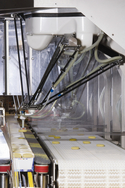Frozen asset
21 June 2006A leading seafood processor has installed what it claims is the “the most modern and efficient packaging technique for frozen fish in the whole of Europe”
Bradman Lake has designed and built two robotic top load packaging lines for Royal Greenland Seafood’s German plant in what Knut Guhr, Royal Greenland’s director of operations, calls “the biggest single investment our company has ever planned”. And for Bradman Lake Germany, says md Marketing Friedrich Kern, the project has been “the biggest single order in the company’s history”.
A world leader in catching, processing and marketing of seafood, Royal Greenland has committed several million Euros to create “the most modern and efficient packaging technique for frozen fish in the whole of Europe,” says md Hendrik Karup Jorgensen.
The Wilhelmshaven facility processes fish fillets coated with breadcrumbs, flour or batter, rectangular and “trapeze” portions breaded or plain and breaded fishcakes as well as bagged products. Until last year, all except the fish fingers were packed by hand, but a continuous increase in sales and ever tougher competition meant that efficiency and performance in both production and packaging had to be raised.
In each of the Bradman Lake lines a sequence of six pick & place robots, a product locating vision system, triple head carton erector, high speed carton closer and wraparound case packer are integrated to pack eight product groups into retail cartons and bulk catering packs.
Including private labels, the two robotic lines pack more than 100 products with different recipes in varying formats and toppings. Carton sizes handled range from 106x100x40mm or 148x148x 22mm up to corrugated boxes 495x140x190mm with a minimum number of end-of-arm tools.
Operators packing manually can tilt and turn a product to fit the box but robots must work to clearly defined packing procedures. It was therefore necessary to change some of Royal Greenland’s pack formats and sizes to take full advantage of the robots’ capabilities.
Working with Timo Lengen, the project manager responsible at Royal Greenland, Bradman Lake identified 14 new folding carton and 37 new corrugated bulk pack formats which resulted in a change of 18 formats in the final packaging and related palletising schemes.
As with many frozen food processors, there is a big difference in height at Wilhelmshaven between freezer exit and interface with the packaging line. Products arriving at a height of 2,500mm, at random and in large numbers, must first be lowered to a working level of approximately 850mm. During that operation, they are aligned by the Product Orientation Feeder (POF) into single file and swiftly conveyed downwards.
The POF consists of a series of driven side belts in which the products change direction and are brought into line. The same method is used by Bradman Lake in the confectionery and bakery industry to feed biscuits or Jaffa cakes in a single lane into a horizontal flow-wrapping machine made by sister company, Autowrappers.
Products arriving at the packaging line are distributed as evenly as possible, but in no clear order across the 600mm wide picking belt. A vision system locates their position and geometry and distributes the tasks equally to the row of six ABB FlexPickers per line which load them into cartons and corrugated catering packs.
Erected folding cartons and corrugated bulk packs ready for loading are transported between side belts in a Carton Management System (CMS) parallel to the picking belt. A servo-drive controls the exact positioning of the open boxes and adjusts the CMS speed to the flow of products arriving..
In both the Wilhelmshaven lines, cartons are erected by a servo-driven triple head AMI carton former, each with a performance of 210 cartons/min, equipped with adjustable magazines and lock style forming tools made of weight-saving carbon fibre. The corrugated packs are also erected by a servo-erector using hot melt. The forming tools are adjustable in x- and y-axis by handwheels with only the plungers having to be changed.
After loading, the cartons are closed by two high-speed Bradman Lake FCC Tri-Liner three-flap closers. Their overhead conveyors with flexible rubber fingers guarantee that any overfilled pack can be closed without causing problems with jamming or machine failures. Finally, the cartons are weighed, metal-checked and coded ready for packing for transport and distribution by two wraparound traypackers from Europack – another Bradman Lake Group company.
“This investment represents a milestone in the history of Royal Greenland Seafood in Wilhelmshaven,” emphasises md Hendrik Karup Jørgensen. “With these two new lines we now have the most modern and efficient packaging technique for frozen fish in the whole of Europe.”



